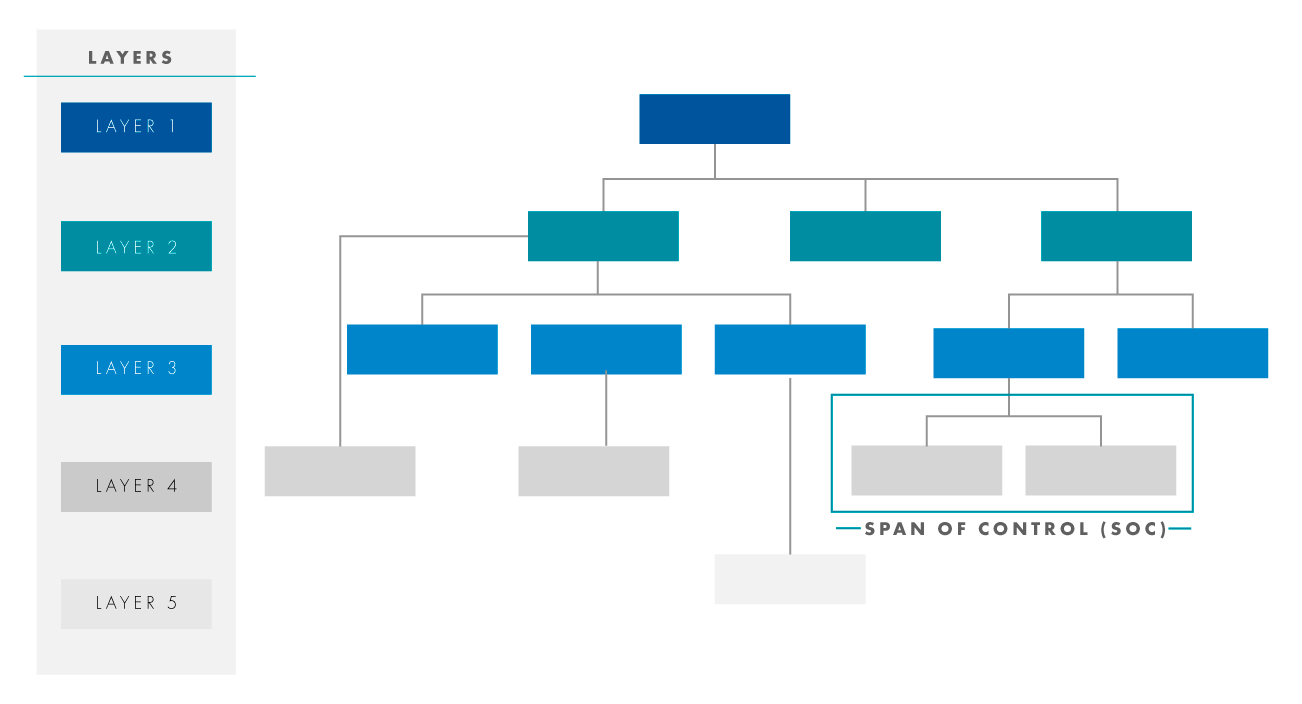Spans and Layers: A Primer for Leaner Organizations
As companies evolve over time, their organizational structure changes to adapt to new strategic and tactical imperatives. Just as a tree grows from a trunk and expands into branches, twigs, leaves, and even fruits, organizations naturally expand functions, departments, and teams to service the needs of their business and stakeholders. One element to consider when working towards a leaner organization is the spans and layers approach.
As such, functions change, departments are created, people are hired, and before long, executives are faced with a new reality: a complex organizational structure with management layers that are too deep, teams that appear to move too slow, a growing and sometimes uncompetitive cost structure, and ideas that have difficulty flowing through the organization at the speed that is required to win in today’s hyper competitive landscape.
Creating a Leaner and Nimbler Organization
A first step towards helping executives transform their organizational structure into a leaner, faster, and more effective construct starts with establishing a factual baseline understanding of the spans of control and management layers within the organization (an analysis commonly known as “spans and layers”).
A spans and layers assessment looks at the span of control of different levels in the organization (i.e., how many direct reports do individual levels of the organization have?) and the different management layers (i.e., how many levels exist from the CEO down the lowest individual contributor in the organization?) present within the current organizational constructs (see Figure 1).

What are the Benefits of Performing a Spans and Layers Analysis?
Performing & executing a spans & layers analysis is the first step towards unlocking a leaner, more empowered organization. Extensive research has shown clear benefits and added value to organizations, some of which include:
- Faster decision making. As layers are reduced, decisions can be implemented faster given fewer vertical layers of approval. In addition, decisions being made closer to where the work actually takes place (instead of several layers removed) can lead to more relevant work being performed inside the organization. In other words, not only can work be done faster (efficiency), but in theory it should also be done better (effectiveness) given it is closer to where the challenges & solutions live. Finally, reducing the number of smaller, non-specialized work groups that might have ‘flown under the radar’ can objectively and quantifiably be identified via spans and layers, especially across large-scale organizations with thousands of employees.
- Improved accountability. Fewer layers translate into faster top-to-bottom (and vice versa) communication. Additionally, we often see that the ‘telephone effect’ dissipates and ideas are less distorted as they move up and down the organization. For leaders looking to transform their organization, this plays a critical role in designing what the future structure needs to look like to support their strategic ambitions.
- Changed behaviors. Contrary to what most leaders might believe, growing the span of control in some supervisor/manager roles actually helps improve the effectiveness of the managerial roles – as managers are unable to micro-manage (and/or increasingly forced to delegate), their tasks & responsibilities can be elevated to other leadership/more strategic roles. As employees are empowered with a broader set of responsibilities, this prioritization exercise can lead improved behaviors provided the right supporting mechanisms are in place to facilitate the transition.
- Leaner cost structures. As spans are increased, fewer roles (whether managerial and/or individual contributors) might be required inside the organization. While this is oftentimes a misguided guiding principle of a spans & layers exercise, leaders need to be cautious about focusing or over-relying on benchmarks as the only parameter to resetting an organizational structure (more on this point below).
Lean and more efficient organizations can make decisions quicker and thus adapt to change more easily and better welcome innovation. Transparency and communication are improved across the organization, and operating costs can be improved as a direct byproduct of delayering.
Clarkston has designed a proprietary tool that allows organizations to quickly develop a baseline understanding of their spans & layers. Learn more about this tool and we can immediately deploy it to fit a variety of needs by contacting our team today.
Subscribe to Clarkston's Insights
Contributions by Belen Berdegue



